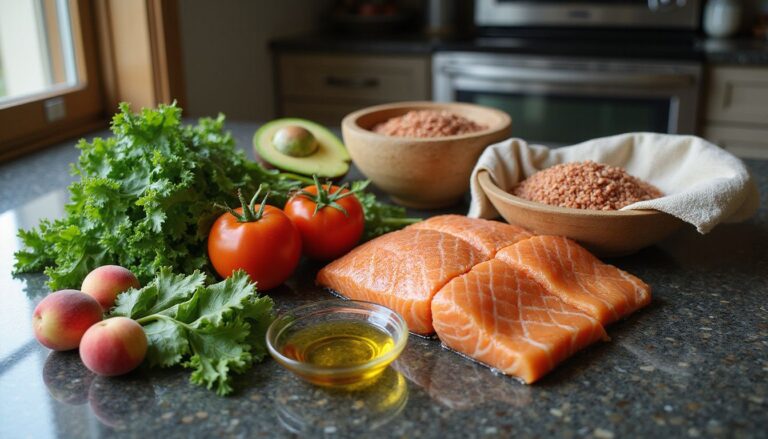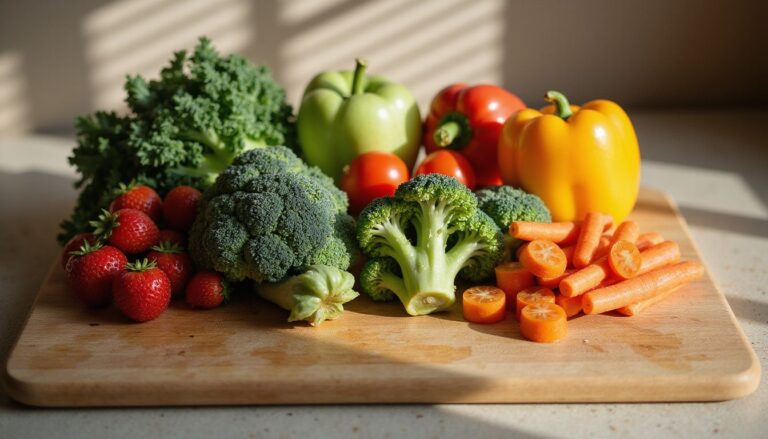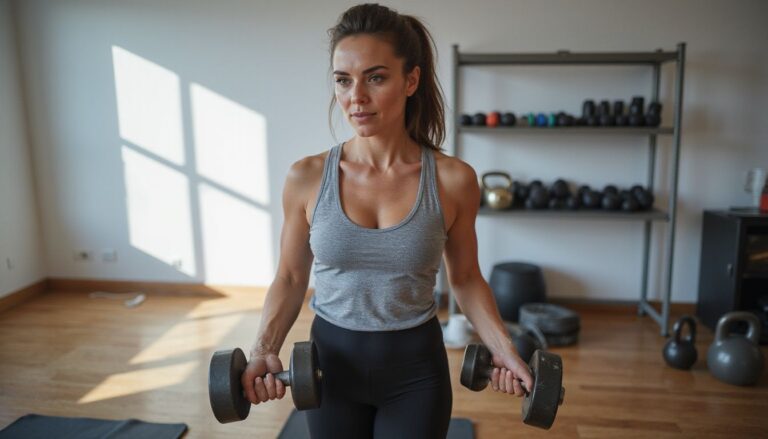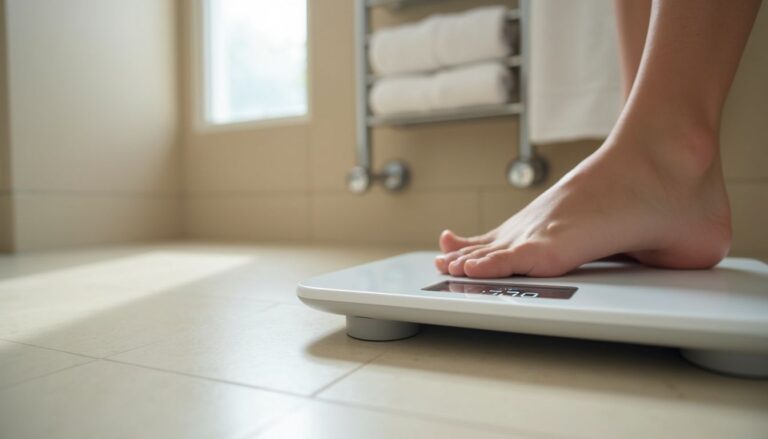Top 10 High Protein Low Calorie Foods For A Healthy Diet Plan
Our Nutrition Assistant AI Suite will transform your body. You will lose fat, get toned, and build muscle. Gain confidence and optimal health.
Trying to lose weight while feeling hungry is exhausting. High-protein, low calorie foods can make a real difference. They help you feel satisfied, protect muscle, and support a healthy diet without piling on calories.
This guide highlights simple, protein-rich foods you can add today, including skinless chicken breast, tuna, eggs, lentils, and more. You will see what to eat, how much, and the best ways to cook it.
Key Takeaways
- High-protein, low calorie picks like skinless chicken breast, nonfat Greek yogurt, and lentils boost fullness and support fat loss.
- Aim for 10 to 35 percent of daily calories from protein, a range supported by USDA guidance.
- Plant options such as edamame, cooked lentils, and tofu supply protein with fewer calories and less saturated fat.
- Choose lean cuts labeled loin or round for red meat, enjoy seafood rich in omega-3 fatty acids, and favor low-fat dairy to protect heart health.
- Pair protein with fiber-rich vegetables to improve fullness, stabilize blood sugar, and aid digestion.
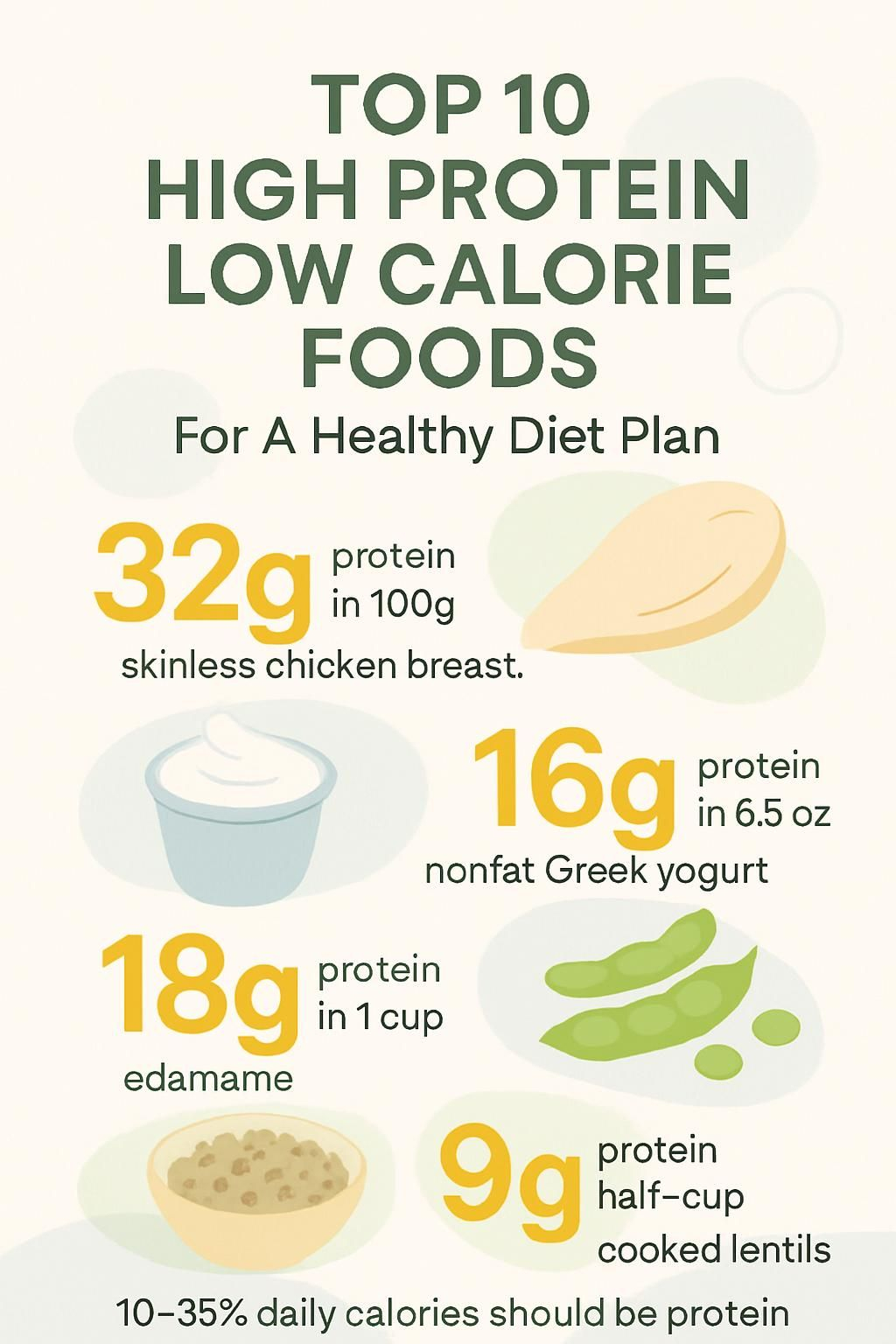
What Are the Benefits of Eating High Protein Low Calorie Foods?
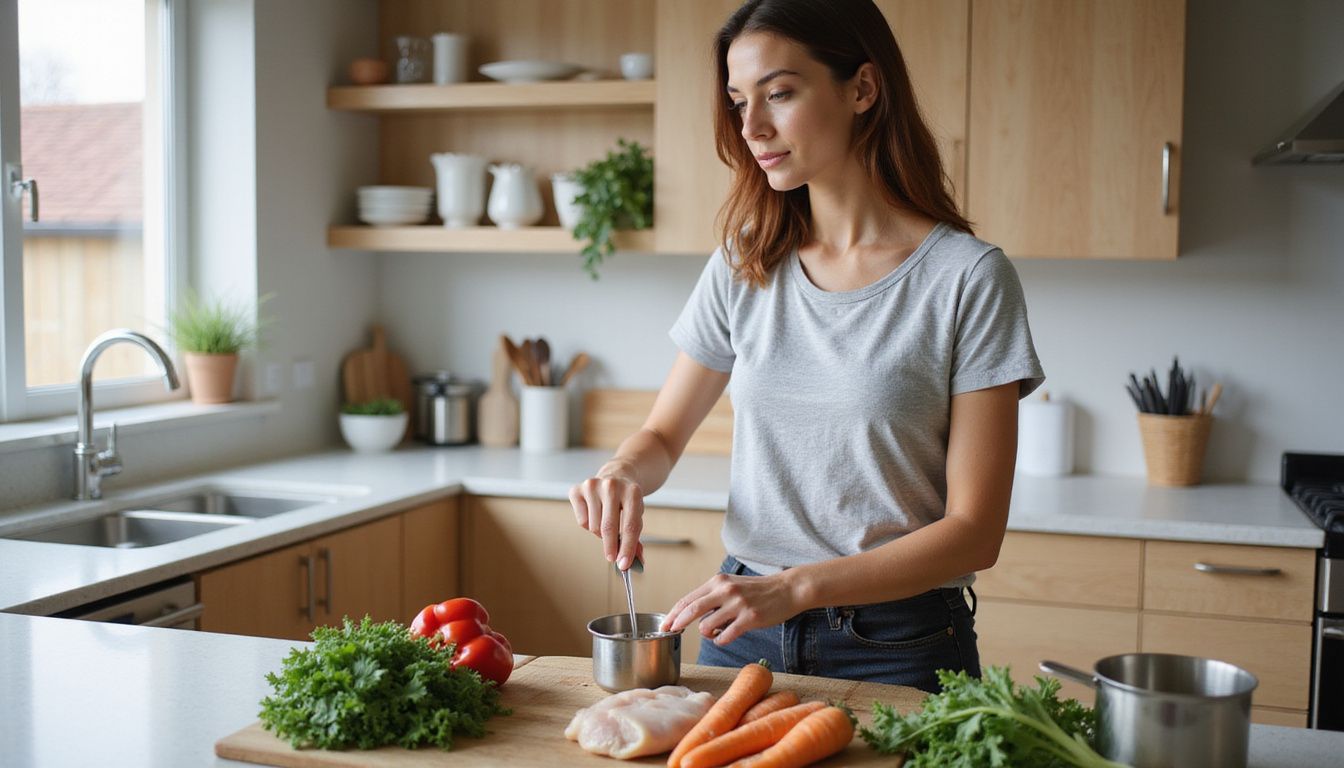
High-protein, low calorie foods let you hit your daily protein target while keeping energy intake in check. That means more nutrition per bite and better support for your healthy diet goals.
How Do These Foods Support Weight Management?
Protein increases satiety, the feeling of fullness after eating. When meals are high in protein and modest in calories, you tend to eat fewer calories overall. For example, nonfat Greek yogurt, 5.5 ounces or 156 grams, delivers about 16 grams of protein for roughly 92 calories.
Roasted chickpeas, 1 cup, provide about 10 grams of protein and nearly 10 grams of fiber at about 210 calories. Fiber slows digestion and works with protein to reduce hunger between meals.
Many adults do well with four to five small meals or snacks spaced out through the day. The USDA suggests getting 10 to 35 percent of total calories from protein sources like lean meat, seafood, eggs, tofu, and low-fat dairy. Cutting about 500 calories per day can lead to roughly one pound lost per week while preserving protein intake.
Let protein lead the plate. It helps you stay satisfied and makes portion control easier.
How Do They Enhance Muscle Growth and Repair?
Protein supplies amino acids, the building blocks your muscles use to repair and grow after exercise. A 3-ounce portion of skinless chicken breast provides about 26 grams of complete protein. Complete protein means it includes all essential amino acids your body cannot make on its own.
Plant choices can work well too. Firm tofu offers about 8 to 10 grams of protein per 3 ounces, and cooked lentils give about 9 grams per half cup. These options are lower in saturated fat than many processed meats.
Adults over 50 often benefit from about 1 gram of dietary protein per kilogram of body weight daily to maintain muscle. Eggs also help. One large egg provides about 6 grams of high-quality protein that supports new muscle protein synthesis.
How Do They Promote Satiety and Reduce Hunger?
Protein slows stomach emptying and sparks hormones that reduce appetite, such as peptide YY. This helps you feel full longer. Nonfat Greek yogurt offers 16 grams of protein in 92 calories per 5.5 ounces, and low-fat cottage cheese has 28 grams of protein in only 163 calories per cup.
Eggs, nuts, beans, and edamame also help control cravings. One large egg gives 6 grams of protein for a steady morning. Almonds provide about 6 grams per ounce. Edamame adds more than 17 grams of protein plus fiber per cup for lasting fullness.
How Do They Improve Overall Health and Nutrition?
Protein is essential for bones, cartilage, muscle, blood, skin, enzymes, and hormones. Eating both animal and plant proteins gives your cells the parts they need to function well. Quinoa offers about 8 grams of protein and 5 grams of fiber per cooked cup. It is one of the few grains that is a complete protein.
Fatty fish like salmon or mackerel add omega-3 fatty acids, heart-friendly fats that support the brain and the cardiovascular system. Low-fat dairy brings calcium and protein to strengthen bones. Soy foods such as tofu and tempeh supply complete protein and minerals like zinc and B vitamins that support energy.
A pattern rich in high-protein, low calorie foods can support immunity, bone strength, and steady muscle growth.
Beans and lentils deliver vitamins, minerals, and fiber for better digestion and more stable blood sugar. Choosing lean meats instead of fatty beef can also lower saturated fat intake, which supports heart health.
What Are the Top 10 High Protein Low Calorie Foods?
You can reach your protein goal while keeping calories modest with the foods below. Use them in meals and snacks for an easy win.
Why Choose Skinless Chicken Breast?
Skinless chicken breast is a lean, high-quality protein source. A 3.5-ounce, 100-gram, serving provides about 32 grams of protein and roughly 158 calories with about 3 grams of fat.
White meat cuts are lower in total and saturated fat than many other animal proteins. Grill, bake, or air-fry for quick meals that support muscle repair. A 3-ounce portion gives about 26 grams of protein, which makes daily targets easier without adding many calories.
Why Is Turkey Breast a Good Option?
Turkey breast packs about 30 grams of protein in a 3.5-ounce portion with roughly 147 calories and very little fat. It contains less saturated fat than many red meats, which supports heart health.
Turkey also offers zinc, selenium, choline, and vitamin B12 for immune function and muscle repair. For ground turkey, pick 93 percent lean or higher to keep calories and saturated fat low.
What Are the Benefits of Tuna and White Fish?
Tuna and white fish give a lot of protein for few calories. A 3.5-ounce serving of white fish has about 19 grams of protein, around 134 calories, and roughly 6 grams of fat.
Canned light tuna provides about 21 grams of protein in 3 ounces for near 98 calories. These fish deliver vitamin D, selenium, vitamin B12, magnesium, and phosphorus. They include omega-3 fats that support the heart and the brain while keeping saturated fat low.
Choose varieties lower in mercury. Canned light tuna is usually a safer pick. Lean seafood helps you meet daily protein needs during weight loss without adding extra calories.
How Do Salmon and Shellfish Fit Into a Healthy Diet?
Salmon and shellfish supply high protein with modest calories. A 3.5-ounce serving of shrimp offers about 22.8 grams of protein for roughly 119 calories and less than 2 grams of fat.
Salmon adds omega-3 fatty acids for cardiovascular health, plus vitamin D and vitamin B12 for bone and nerve support. Shellfish like crab and shrimp add minerals such as zinc, selenium, and iron that support the immune system.
These lean proteins help build muscle and manage weight because they are filling yet low in calories. Quick options like grilled salmon or a shrimp stir-fry make weekday meals simple.
What Makes Eggs and Egg Whites High Protein?
Eggs are a complete protein source. One large egg has about 6 grams of protein. The white contains most of the protein with almost no fat.
Two large eggs, about 100 grams, deliver more than 12 grams of protein for only 143 calories. One whole egg plus two whites gives around 13.5 grams of protein for about 106 calories and less than 5 grams of fat. Scrambled egg whites with spinach on whole-grain toast make a fast, filling meal.
Why Pick Greek Yogurt (Low-Fat or Fat-Free)?
Nonfat Greek yogurt, 5.5 ounces or 156 grams, provides about 16 grams of protein with roughly 92 calories and less than 1 gram of fat. It offers more protein than regular yogurt, which helps you reach daily protein goals without many calories.
Calcium, phosphorus, potassium, and selenium support bone health. Greek yogurt also boosts fullness, so it works well as a snack or a base for fruit and nuts.
How Does Cottage Cheese Provide Protein?
Low-fat cottage cheese is a protein standout. One cup delivers about 28 grams of protein, roughly 163 calories, and about 2 to 3 grams of fat. A half cup has around 14 grams of protein for under 90 calories.
It is rich in calcium, selenium, vitamin B12, and phosphorus. The casein protein in cottage cheese digests slowly, which helps you stay full and supports muscle maintenance. Pair it with fruit or nuts for a portable, balanced snack.
What Are the Advantages of Tofu and Tempeh?
Tofu and tempeh are high-quality plant-based proteins. Firm tofu typically offers 8 to 10 grams of protein per 3 ounces, while tempeh provides about 15 to 18 grams per 3 ounces. Both are complete proteins, so they contain all essential amino acids.
They also supply minerals such as calcium, manganese, and copper that support bones and heart health. Tofu absorbs flavors well for stir-fries and curries. Tempeh has a firmer bite and works in grain bowls, sandwiches, or veggie wraps.
Why Include Edamame in Your Diet?
Edamame delivers more than 17 grams of protein per cup, about 155 grams, with roughly 188 calories and around 8 grams of fat. It is a complete plant protein, which helps you meet daily protein needs without animal foods.
Edamame also brings fiber, iron, vitamin C, and calcium. These nutrients support the immune system and bone strength. Toss shelled edamame into salads or stir-fries to boost protein fast.
What Protein Do Lentils, Beans, and Chickpeas Offer?
Cooked lentils provide about 9 grams of protein per half cup. Cooked kidney beans offer about 7 to 8 grams in the same portion. One cup of roasted chickpeas gives around 10 to 11 grams of protein for about 210 calories.
These legumes also supply fiber, complex carbohydrates, and key micronutrients like folate and manganese. They support digestive health and help balance blood sugar.
Animal-Based High Protein Low Calorie Options
Animal proteins supply iron and vitamin B12, which support red blood cells and muscle. These choices can make your eating plan more effective while keeping calories in check.
Lean Meats Like Pork Loin and Ground Turkey
Pork loin and ground turkey are smart lean protein picks. A 3.5-ounce, 100-gram, serving of pork loin provides about 26 grams of protein, roughly 143 calories, and about 3.5 grams of fat.
Choose ground turkey labeled 93 percent lean or higher. Leaner cuts help you limit saturated fat, which supports heart health and weight goals. Pick fresh cuts instead of processed meats to keep sodium in a healthy range.
Fish Rich in Omega-3 Fatty Acids Like Mackerel and Herring
Mackerel and herring provide 17 to 20 grams of protein per 3 ounces and deliver omega-3 fatty acids. Omega-3s are healthy fats that lower inflammation and support the heart and brain.
Favor fish lower in mercury for safety. White fish offers around 19 grams of protein per 100 grams with about 134 calories and under 6 grams of fat. Shrimp is another lean option with nearly 23 grams of protein per serving and very few calories.
Dairy Products Like Skim Milk and String Cheese
Skim milk and part-skim mozzarella string cheese offer convenient protein with few calories. Four ounces of skim milk provides about 4 grams of protein plus calcium for bones.
Pair 1 ounce of string cheese with 1 ounce of almonds for about 13 grams of protein, roughly 250 calories, and helpful fiber from the nuts. Low-fat dairy supports muscle repair and bone health with protein, calcium, and other minerals.
Plant-Based High Protein Low Calorie Options
Plant-based proteins bring fiber, vitamins, and minerals along with protein. They fit well into a healthy diet plan and add variety to your meals.
Nuts and Seeds Like Almonds and Chia Seeds (In Moderation)
Almonds and chia seeds supply plant protein, healthy fats, and minerals like vitamin E and magnesium. One ounce of almonds has about 6 grams of protein. Two tablespoons of almond butter provide around 6 to 7 grams, and peanut butter offers about 7 grams per two tablespoons.
These foods are calorie-dense. Keep portions small to manage weight. Pack a small bag of nuts for work or school. Stir chia seeds into oatmeal, smoothies, or Greek yogurt to increase protein and fiber with little effort.
Quinoa and Other Whole Grains
Quinoa offers about 8 grams of protein and 5 grams of fiber per cooked cup. It is a complete protein and naturally gluten-free. Other whole grains like brown rice, barley, bulgur, and farro add B vitamins and minerals such as magnesium.
Whole grains give slow-digesting carbohydrates for steady energy. Combine them with legumes or vegetables to build meals that keep you full and support weight management.
Soy Products Like Soy Curls and Soy Milk
Soy foods are reliable plant proteins. A 4-ounce serving of soy milk has about 3 to 4 grams of protein, and fortified versions add calcium and vitamin D. Soy curls, tofu, and tempeh provide complete proteins that support muscle maintenance and recovery.
Use soy in salads, stir-fries, curries, or breakfast bowls. Edamame is a handy snack with more than 17 grams of protein per cup and can help you reach daily targets without extra calories.
How Can You Include High Protein Low Calorie Foods in Your Diet?
Simple swaps and planning make higher protein eating easy. You can increase protein without raising calories or fat.
Why Is Portion Control and Mindful Eating Important?
Portion control keeps calories in line, even with healthy foods like chicken or edamame. U.S. guidelines suggest 10 to 35 percent of daily calories from protein.
Very high intakes, above 2 grams per kilogram of body weight per day, may strain the kidneys for some people. Mindful eating, paying attention to hunger and fullness cues, helps you avoid overeating. Four or five small meals can stabilize appetite and energy.
How Does Pairing With Fiber-Rich Vegetables Help?
Protein plus fiber creates lasting fullness. Fiber slows digestion and helps steady blood sugar. Vegetables, fruits, whole grains, nuts, seeds, and legumes are top sources.
Try chicken with roasted broccoli or lentil soup with carrots. One cup of roasted chickpeas delivers roughly 10 to 11 grams of protein and near 9 to 10 grams of fiber. Cooked quinoa provides 8 grams of protein and 5 grams of fiber per cup.
What Are Healthy Cooking Methods to Use?
Grill, bake, steam, or air fry to keep added fats low. Baking chicken or vegetables keeps calories lower than deep frying. Steam broccoli as a side for baked salmon to preserve vitamins and minerals.
Skip heavy sauces and choose herbs, spices, citrus, or vinegar for flavor. These methods help protect heart health and keep meals satisfying. Swap fava beans for higher-fat sides to increase fiber and protein.
Next, see how to combine these proteins and methods into balanced meals and snacks.
How to Incorporate These Foods Into Balanced Meals and Snacks?
Build each meal with a lean protein, a high-fiber carb, and colorful produce. For breakfast, scramble egg whites with spinach and serve on whole-grain toast.
For lunch, make a grilled chicken salad with quinoa and mixed greens. Snack on almonds with string cheese for about 13 grams of protein in roughly 250 calories, or enjoy a half cup of low-fat cottage cheese for about 14 grams of protein.
Dinner ideas include baked salmon with steamed broccoli and roasted sweet potatoes, shrimp tacos with cabbage slaw, or turkey-stuffed peppers with quinoa. A hearty lentil soup with roasted vegetables delivers protein, fiber, and minerals. Rotate skinless chicken breast, fish rich in omega-3 fats like mackerel, and soy foods such as tofu or edamame across the week.
What Are Some High Protein Meal Ideas?
These quick ideas use high-quality sources and nutrient-dense sides. Mix and match to fit your schedule.
How to Make Grilled Chicken Salad With Quinoa and Mixed Greens?
Grill a skinless chicken breast, about 3.5 ounces or 100 grams, for roughly 32 grams of protein and about 158 calories. Slice it after resting.
Fill a bowl with mixed greens. Add 1 cup cooked quinoa for about 8 grams of protein and 5 grams of fiber. Top with the warm chicken.
Dress lightly with olive oil and lemon juice. This meal balances protein with fiber and micronutrients, which helps you stay full and support muscle repair.
What Is a Simple Recipe for Baked Salmon With Steamed Broccoli and Sweet Potatoes?
Heat the oven to 400°F. Season a 3.5-ounce salmon fillet with salt, pepper, and lemon. Bake for about 15 minutes until it flakes easily. Salmon provides protein and omega-3s that support heart and brain health.
Steam broccoli for about 7 minutes to keep texture and nutrients. Roast sliced sweet potatoes on a sheet pan for about 25 minutes until tender. This plate covers protein, healthy fats, fiber, and complex carbs.
How to Prepare Scrambled Egg Whites With Spinach and Whole-Grain Toast?
Separate four egg whites, about 3.6 grams of protein each. Lightly oil a nonstick skillet. Sauté a cup of fresh spinach until wilted, then add the egg whites and cook gently until set.
Serve with two slices of whole-grain toast for extra fiber. This simple meal keeps calories modest and supports fullness for hours.
What Is a Good Lentil Soup Recipe With Roasted Vegetables?
Roast carrots, mushrooms, and celery at 400°F for about 20 minutes to deepen flavor. In a pot, sauté onions and garlic until soft, then add the roasted vegetables.
Stir in cooked lentils, about 9 grams of protein per half cup, and cover with vegetable broth. Simmer 10 minutes. For extra protein, finish each bowl with a spoonful of Greek yogurt or a few cubes of tofu.
How Do You Choose High Protein Low Calorie Foods?
A little label reading goes a long way. Focus on foods that deliver more protein for fewer calories, and that bring helpful nutrients like fiber, calcium, and omega-3s.
Why Focus on Nutrient-Dense Options?
Nutrient-dense foods provide more vitamins, minerals, and protein with fewer calories. Lean chicken breast or fish helps control hunger and supports weight goals. Greek yogurt with berries often satisfies longer than chips or sweets.
Protein plus fiber, like lentils or edamame, keeps you full and on track. Mixing plant and animal proteins can improve your nutrient coverage. Research and U.S. guidelines suggest higher protein patterns can support healthy weight and aging when balanced with vegetables and whole grains.
What Foods Should You Avoid (High Saturated Fat or Sodium)?
Limit foods high in saturated fat and sodium to protect heart health. Skip fatty or processed meats such as sausage, bacon, and some lunch meats, which often carry more than 6 grams of saturated fat and over 400 milligrams of sodium per serving.
Cut back on fried foods, fast-food burgers or nuggets, and salty snacks like chips. Use olive oil instead of butter, and season with herbs, citrus, or spices instead of salt. Restaurant meals can reach your full daily sodium allowance in one sitting, about 2,300 milligrams according to the American Heart Association.
How to Check Protein-to-Calorie Ratio for the Best Choices?
Look up protein grams and total calories per serving. Then divide grams of protein by calories. Higher numbers mean more protein for fewer calories.
Skinless chicken breast has about 32 grams of protein and 158 calories per 100 grams, which is roughly 0.20 grams of protein per calorie. Nonfat Greek yogurt provides about 16 grams for 92 calories, around 0.17 grams per calorie. Aim for foods at or above about 0.15 when you want protein-dense choices.
Comparing turkey breast, about 30 grams of protein for 147 calories, to salmon, about 22 grams for 142 calories, shows both are lean options. Turkey edges out salmon on this ratio, while salmon brings omega-3s that support heart health.
What Are Common Myths About High Protein Low Calorie Diets?
Myths can cause confusion and stalls. Clearing them up helps you choose food with confidence.
Is It True That High Protein Diets Are Only for Bodybuilders?
No. Higher protein intake helps many people, not only lifters. It protects muscle during weight loss, supports blood sugar control, and improves fullness. Needs vary by age, activity, and goals.
Adding lean proteins like chicken breast or Greek yogurt can reduce age-related muscle loss and keep you stronger over time.
Are Plant-Based Proteins Incomplete?
Some plant proteins lack one or more essential amino acids. Eating a variety of plants, such as beans, lentils, grains, nuts, and seeds, covers the full set across the day. Soy and quinoa are complete proteins by themselves.
Mixing plant and animal sources, if you eat both, also improves balance and helps you meet daily protein needs with ease.
Do High Protein Diets Harm Kidney Health?
Very high protein intakes can stress the kidneys, especially if you already have kidney disease. Most healthy adults do well within the 10 to 35 percent of calories range or about 0.8 to 1.6 grams per kilogram of body weight per day, depending on activity.
If you consider going much higher, talk with a healthcare professional first. Keep fiber intake strong with vegetables, fruits, and whole grains to support digestion while you raise protein.
Conclusion
Choosing high-protein, low calorie foods supports weight management, muscle strength, and steady energy. Lean meats, seafood, eggs, dairy, and plant proteins each add something useful to a healthy diet. Pair them with whole grains, vegetables, and fruit to cover vitamins, minerals, and fiber.
Set a realistic protein target and build meals around it. If you have medical conditions, including kidney issues, check with a qualified clinician before making big changes. Small, smart swaps each day can move you toward your goals while keeping food enjoyable.
Sources: USDA Dietary Guidelines for Americans, American Heart Association, and peer-reviewed studies on protein intake and satiety.
FAQs
1. What are the top 10 high protein low calorie foods for a healthy diet plan?
Egg whites, cod fillets, turkey breast, Greek yogurt (nonfat), cottage cheese (low-fat), lentils, tofu, shrimp, chicken breast (skinless), and black beans rank among the best options. These foods provide substantial protein with fewer calories per serving compared to many alternatives. Research from the USDA National Nutrient Database supports these choices.
2. How do high protein low calorie foods help with weight management?
High protein low calorie foods increase satiety and preserve muscle mass during weight loss efforts. Studies published in The American Journal of Clinical Nutrition show that higher dietary protein intake can reduce hunger and support fat loss while maintaining lean tissue.
3. Can plant-based options be included in a high protein low calorie meal plan?
Yes; lentils, tofu, and black beans offer significant plant-based proteins with modest caloric content. Including these items helps diversify nutrient sources while supporting heart health according to research from Harvard T.H. Chan School of Public Health.
4. What is an example of using these foods in daily meals?
For breakfast I often choose egg whites scrambled with spinach or tomatoes for flavor without extra calories or fat content. This approach keeps me full through mid-morning meetings while helping me meet my daily nutrition goals.
Summary: High protein low calorie foods such as poultry cuts without skin, seafood like cod or shrimp, dairy products like nonfat Greek yogurt or cottage cheese, plus legumes including lentils and black beans support healthy eating plans by promoting fullness and preserving muscle mass during weight control efforts.



